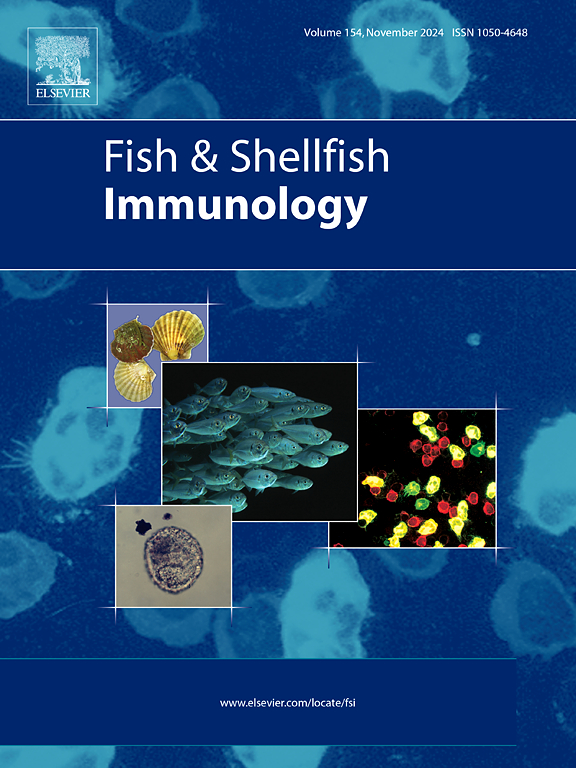饲料中添加发酵马尾藻对尼罗罗非鱼生长性能、肠道健康、免疫抗氧化相关基因反应和细菌感染抗性的潜在影响
IF 3.9
2区 农林科学
Q1 FISHERIES
引用次数: 0
摘要
近年来,发酵褐藻因其高功能性和大量的生物活性成分而引起了人们的兴趣。因此,本研究利用植物乳杆菌和酿酒酵母益生菌,研究饲料中添加发酵马尾藻(DFSM)对尼罗罗非鱼(Oreochromis niloticus)生长性能、肠道健康、血液指标、抗氧化水平和免疫反应的影响。试验60 d,选取平均体重(21.59±1.06 g)的尼罗罗非鱼(15尾/水缸,4个重复)饲喂5种等氮饲料,分别添加0.0%(对照)、0.5%、1%、2%和3%的DFSM。饲养试验结束后,将嗜水气单胞菌菌株腹腔注射到各组鱼体内。与对照饲料相比,添加0.5%以上的DFSM可显著提高尼罗罗非鱼的所有生长指标。结果表明,饲料中添加DFSM可改善鱼的肠道健康和血液指标,特别是在饲料中添加2和3 % DFSM的鱼中。与对照饲料相比,DFSM饲料中MDA值降低,免疫指标(吞噬活性和溶菌酶)和抗氧化剂(SOD和CAT)升高,其中DFSM饲料含量为2和3 %时尤为明显。与饲粮0.5%、1%和对照组相比,饲粮中添加2%和3% DFSM显著上调了CAT、SOD、GPx和Nrf2基因的表达。相反,IL-8、IL-1β和TNF基因表达在对照组中上调,而在饲粮中添加2和3 % DFSM的鱼中下调。组织学分析显示,随着DFSM添加量的增加,饲喂DFSM的鱼的所有组织都表现出完整的结构改善。饲粮中DFSM含量为2 %和3 %的组在嗜水单胞菌感染攻击后的存活率高于对照组。本研究得出结论:尼罗罗非鱼饲料中添加2.5 ~ 3.0 % DFSM可提高其生长性能、健康状况和抗感染能力。本文章由计算机程序翻译,如有差异,请以英文原文为准。
Potential effects of dietary fermented Sargassum muticum on growth performance, intestinal health, immune-antioxidant related gene responses, and resistance to bacterial infection in Nile tilapia
Recently, fermented brown algae have gained interest as a food source due to their high functionality and numerous bioactive components. Therefore, the current study used Lactobacillus plantarum and Saccharomyces cerevisiae probiotics to examine the possible effects of dietary fermented Sargassum muticum (DFSM) on the growth performance of Nile tilapia (Oreochromis niloticus), intestinal health, blood indices, antioxidant levels, and immune response. For 60 days, Nile tilapia (15 fish/aquarium) with an average weight (21.59 ± 1.06 g, four replicates) were fed five isonitrogenous diets that contained 0.0 % (control), 0.5 %, 1 %, 2 %, and 3 % DFSM. The bacterial Aeromonas hydrophila strain was injected intraperitoneally into fish of each treatment following the feeding trial. All growth indices in Nile tilapia were significantly enhanced with a DFSM inclusion above 0.5 %, compared to the control diet. The results displayed that the DFSM in the diet improved fish intestinal health and blood indices, especially in fish fed a diet containing 2 and 3 DFSM %. The fish fed the DFSM displayed a reduced MDA value compared to the control diet and a rise in immunological indices (phagocytic activity and lysozyme) and antioxidants (SOD and CAT), especially at 2 and 3 DFSM % diet. Fish fed 2 and 3 % DFSM diet had significantly upregulated the genes CAT, SOD, GPx, and Nrf2 expression compared to the diet 0.5,1 % and control groups. Conversely, IL-8, IL-1β, and TNF gene expression were upregulated in the control one and downregulated in fish fed a diet containing 2 and 3 DFSM %. The histological analysis revealed that all tissues examined in fish fed DFSM exhibited intact structural improvements as the amount of DFSM supplementation increased. Fish groups fed a diet containing 2 and 3 DFSM % diet exhibited higher survival rates after an A. hydrophila infection challenge than the control group. The study concluded that Nile tilapia requires a 2.5 to 3.0 DFSM% diet to boost growth performance, health status, and infection resistance.
求助全文
通过发布文献求助,成功后即可免费获取论文全文。
去求助
来源期刊

Fish & shellfish immunology
农林科学-海洋与淡水生物学
CiteScore
7.50
自引率
19.10%
发文量
750
审稿时长
68 days
期刊介绍:
Fish and Shellfish Immunology rapidly publishes high-quality, peer-refereed contributions in the expanding fields of fish and shellfish immunology. It presents studies on the basic mechanisms of both the specific and non-specific defense systems, the cells, tissues, and humoral factors involved, their dependence on environmental and intrinsic factors, response to pathogens, response to vaccination, and applied studies on the development of specific vaccines for use in the aquaculture industry.
 求助内容:
求助内容: 应助结果提醒方式:
应助结果提醒方式:


